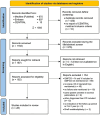Redisplacement rate after bony hip reconstructive surgery in nonambulatory patients with cerebral palsy: a systematic review and meta-analysis
- PMID: 39087495
- PMCID: PMC11370722
- DOI: 10.1530/EOR-23-0043
Redisplacement rate after bony hip reconstructive surgery in nonambulatory patients with cerebral palsy: a systematic review and meta-analysis
Abstract
Purpose: Up to 90% of nonambulatory patients with cerebral palsy (CP) experience hip displacement during their lifetime. Reconstructive surgery is recommended. Redisplacement rate is an outcome parameter.
Methods: In a systematic literature review (MEDLINE, Embase and CENTRAL databases) until January 2023 we searched for reports with redisplacement rates after bony hip reconstructive surgery in nonambulatory patients. Quantitative data synthesis, subgroup analysis and meta-regression with moderators were carried out.
Results: The pooled mean redisplacement rate was 16% (95% CI: 12-21%) with a prediction interval of 3-51% (Q: 149; df: 32; P < 0.001; I2: 78%; τ2: 0.67 and τ: 0.82) in 28 studies (1540 hips). Varus derotation osteotomy (VDRO) alone showed a higher redisplacement rate than VDRO + pelvic osteotomy (30% vs 12%, P < .0001). Mean age in the VDRO-alone subgroup was 7.1 years and in the combined group 9.5 years (P = .004). In meta-regression, lower redisplacement rates were observed with higher preoperative migration index (MI) (correlation coefficient: -0.0279; P = .0137), where comprehensive surgery was performed. Variance in true effects are explained by type of bone surgery (57%), preoperative MI (11%), age (5%) and MI for definition of failure (20%). No significant reduction in the redisplacement rate could be observed over the mid-years of studies (1977-2015).
Conclusion: Our pooled data support the more extensive surgical approach in patients with high preoperative MI and emphasize the superiority of combined surgery. Studies should report a coordinated set of parameters and outcome classifications according to internationally accepted gradings to reduce redisplacement in future.
Keywords: cerebral palsy; hip reconstruction; redisplacement.
Conflict of interest statement
The authors declare that there is no conflict of interest that could be perceived as prejudicing the impartiality of the study reported.
Figures






References
LinkOut - more resources
Full Text Sources
Miscellaneous

